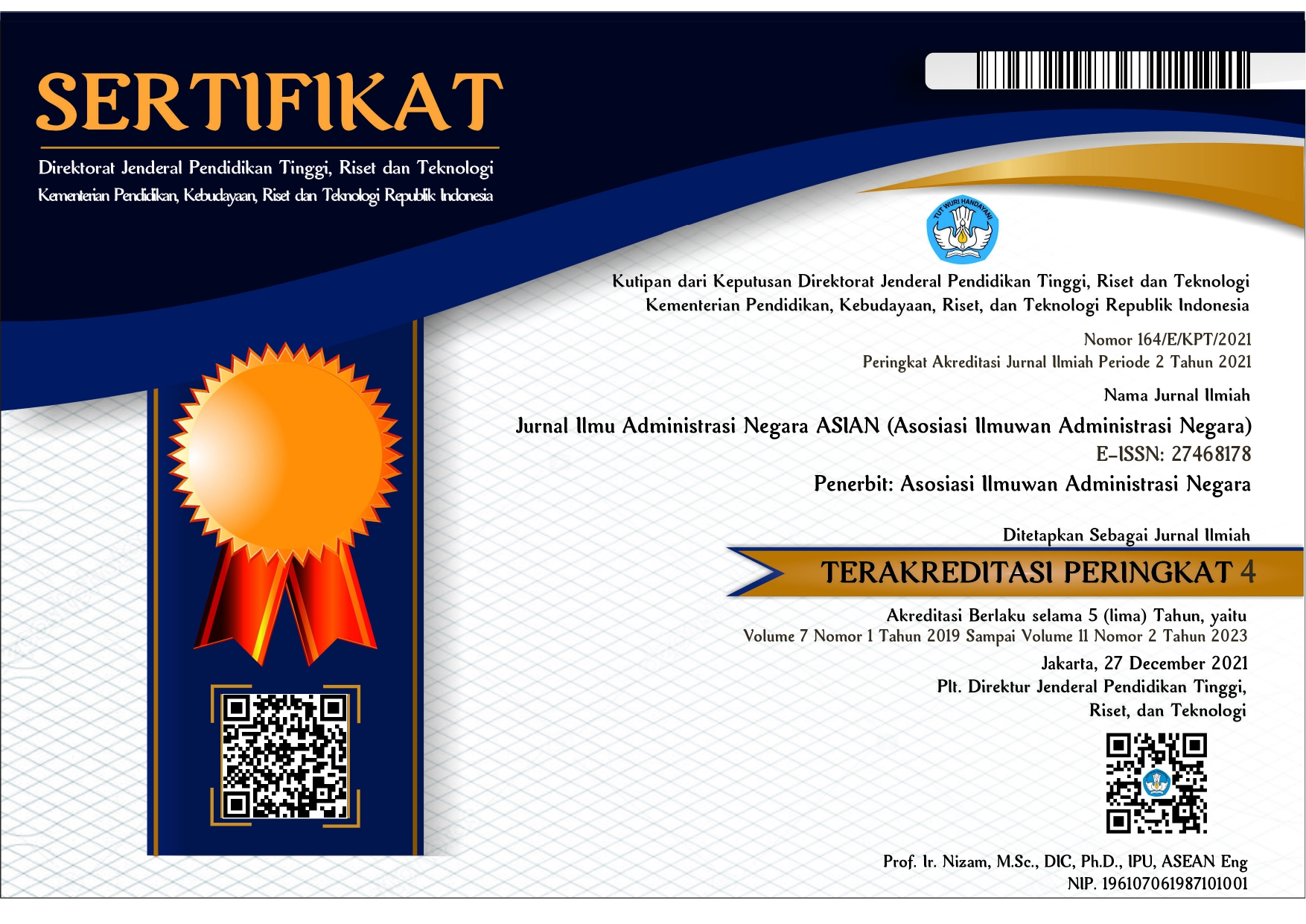Pengaruh Kualitas Pelayanan Posyandu Terhadap Partisipasi Ibu dalam Pencegahan Stunting: Studi di Wilayah Rural Kabupaten Lima Puluh Kota
 Abstract views: 229
,
Abstract views: 229
,
 PDF downloads: 294
PDF downloads: 294
Abstract
Stunting has emerged as a critical public health challenge threatening human resource quality in Indonesia, with a national prevalence of 21.5% exceeding the WHO tolerance threshold of 20%. Situjuah Limo Nagari Sub-district faces substantial challenges with 110 reported stunting cases and fluctuating maternal participation rates in posyandu programs ranging from 36-60%, indicating a misalignment between service quality and community engagement. This study aims to analyze the influence of posyandu service quality on maternal participation in stunting prevention programs in Situjuah Limo Nagari Sub-district, Lima Puluh Kota Regency. The research employed a quantitative associative approach utilizing simple random sampling of 87 mothers with stunted children, implementing validated instruments measuring five SERVQUAL service quality dimensions and three participation indicators. The analysis revealed a significant influence of service quality on maternal participation with a coefficient of determination R² = 0.580 (58%) and t-calculated = 10.002 > t-table = 1.988 at significance level p < 0.001. The regression equation Y = 10.871 + 0.354X confirms that each unit increase in service quality enhances participation by 0.354 units. These findings provide empirical justification for investing in posyandu service quality improvement as a cost-effective strategy for optimizing community participation and achieving sustainable stunting reduction targets.
Downloads
References
Andersen, R., & Newman, J. F. (2005). Societal and individual determinants of medical care utilization in the United States. The Milbank Quarterly, 83(4), Online-only.
Arifin, Z., Sutomo, S., & Wahyudi, E. (2018). Pengaruh Kualitas Pelayanan Terhadap Partisipasi Pria Dalam Program Keluarga Berencana Di Kabupaten Jember (Studi Pada Peserta Kb Metode Operasi Pria Di Dinas Pemberdayaan Perempuan, Perlindungan Anak Dan Keluarga Berencana Kabupaten Jember). Majalah Ilmiah Dian Ilmu, 17(2).
Berry, L. L. (1988). SERVQUAL: A multiple-item scale for measuring consumer perceptions of service quality. Journal of retailing, 64(1), 12-40.
Black, R. E., Victora, C. G., Walker, S. P., Bhutta, Z. A., Christian, P., De Onis, M., ... & Uauy, R. (2013). Maternal and child undernutrition and overweight in low-income and middle-income countries. The lancet, 382(9890), 427-451.
Buulolo, A., Pardede, P. D. K., & Laia, S. (2024). Pengaruh Kualitas Pelayanan Publik Terhadap Partisipsasi Masyarakat dalam Pembangunan Desa Hilizalootano Kecamatan Mazino Kabupaten Nias Selatan. Jurnal Governance Opinion, 9(1), 46-60.
Cook, T. D., Campbell, D. T., & Day, A. (1979). Quasi-experimentation: Design & analysis issues for field settings (Vol. 351). Boston: Houghton Mifflin.
Creswell, J. W., & Creswell, J. D. (2017). Research design: Qualitative, quantitative, and mixed methods approaches. Sage publications.
DeVellis, R. F., & Thorpe, C. T. (2021). Scale development: Theory and applications. Sage publications.
Fatimah, S., Jumaidi, J., & Paulina, S. (2024). Pengaruh Kualitas Pelayanan terhadap Partisipasi Masyarakat dalam Program Posyandu Lansia pada Desa Patarikan Kecamatan Banjang. Jurnal Pelayanan Publik, 1(4), 1498-1507.
Field, A. (2024). Discovering statistics using IBM SPSS statistics. Sage publications limited.
Grönroos, C. (1990). Service management and marketing: Managing the moments of truth in service competition. Lexington book.
Gujarati, D. N., & Porter, D. C. (2009). Basic econometrics. McGraw-hill.
Hair, J. F. (2009). Multivariate data analysis.
Hair, J. F., Black, W. C., Babin, B. J., & Anderson, R. E. (2018). Multivariate data analysis (8th ed.). Cengage Learning.
Homans, G. C. (1974). Social behavior: Its elementary forms.
Kementerian Kesehatan RI. (2023). Survei Status Gizi Indonesia (SSGI) 2023. Jakarta: Kementerian Kesehatan Republik Indonesia.
Oliver, R. L. (1997). Satisfaction: A behavioral perspective on the consumer.
Pallant, J. (2020). SPSS survival manual: A step by step guide to data analysis using IBM SPSS. Routledge.
Parasuraman, A., & Berry, L. L. (1990). Delivering quality service: Balancing customer perceptions and expectations. Free Press.
Pretty, J. N. (1995). Participatory learning for sustainable agriculture. World development, 23(8), 1247-1263.
Theresia, A., Andini, K. S., Nugraha, P. G., & Mardikanto, T. (2014). Pembangunan berbasis masyarakat: acuan bagi praktisi, akademisi, dan pemerhati pengembangan masyarakat. Penerbit Alfabeta.
Wibowo, M. T. H. (2018). Pengaruh kualitas pelayanan terhadap partisipasi masyarakat dalam pembuatan Sertifikat Tanah di Badan Pertanahan Nasional Kabupaten Sumedang pada Tahun 2013-2017 (Doctoral dissertation, UIN Sunan Gunung Djati Bandung).
World Health Organization. (2018). Child stunting data visualizations dashboard. Geneva: WHO Press.
Yamane, T. (1969). Statistics: An introductory analysis (2nd ed.). Harper and Row.
Zeithaml, V. A., & Parasuraman, A. (2004). Service quality. Cambridge, MA.
Zeithaml, V. A., Bitner, M. J., & Gremler, D. D. (2000). Services marketing: Integrating customer focus across the firm.
Copyright (c) 2025 Jurnal Ilmu Administrasi Negara AsIAN (Asosiasi Ilmuwan Administrasi Negara)

This work is licensed under a Creative Commons Attribution-ShareAlike 4.0 International License.
Authors who publish with this journal agree to the following terms:
1. Copyright on any article is retained by the author(s).
2. The author grants the journal, right of first publication with the work simultaneously licensed under a Creative Commons Attribution License that allows others to share the work with an acknowledgment of the work’s authorship and initial publication in this journal.
3. Authors are able to enter into separate, additional contractual arrangements for the non-exclusive distribution of the journal’s published version of the work (e.g., post it to an institutional repository or publish it in a book), with an acknowledgment of its initial publication in this journal.
4. Authors are permitted and encouraged to post their work online (e.g., in institutional repositories or on their website) prior to and during the submission process, as it can lead to productive exchanges, as well as earlier and greater citation of published work.
5. The article and any associated published material is distributed under the Creative Commons Attribution-ShareAlike 4.0 International License








